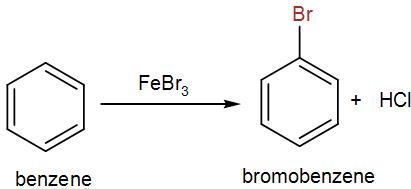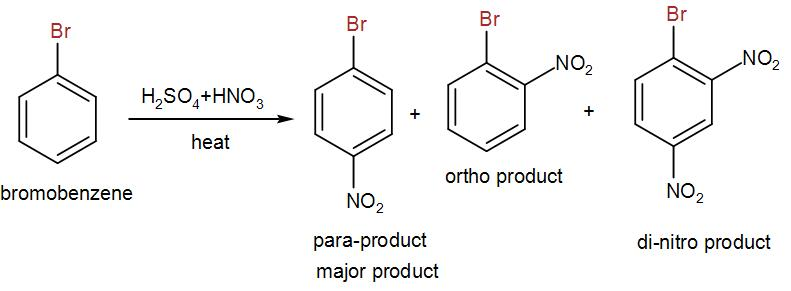
How can the following conversions be carried out?
Benzene to 4-bromonitrobenene.
Answer
574.2k+ views
Hint: Conversion of benzene to 4-bromonitrobenzene is a two-step process. Benzene converts to bromobenzene through a brominating catalyst. The brominated product is heated with mixed acid to get the required product.
Complete step by step solution:
We know that benzene is an organic compound with formula ${{C}_{6}}{{H}_{6}}$. We can convert it to certain compounds by adding required reagents.
In the question, we have been asked to convert benzene to 4-bromonitrobenzene.
Now as we can understand from the name itself, 4-bromonitrobenzene contains bromine and nitro- groups as substituents in the benzene ring.
Now firstly, let us discuss the reagents for bromination of benzene. Bromine undergoes electrophilic substitution in presence of a catalyst to give us the brominated product. We use iron bromide here and the product is bromobenzene. We can write the reaction as-

Now, for nitration, we used mixed acid i.e. sulphuric acid and nitric acid. We heat bromobenzene with the mixed acid and we obtain three different nitrated products. One is the para-product which is the major product and the other is ortho-product and we also obtain a di-nitro product. We can write the reaction as-

Here, the para-product us the 4-bromonitrobenzene.
Therefore, we can write the whole reaction of conversion of benzene to 4-bromonitrobenzene as-

Therefore, the above reaction is the required answer.
Note: Here, for the bromination of benzene we can either use aluminium (III) bromide or iron (III) bromide. Generally, we use iron (III) bromide because it is cheaper and readily available. We even use the chloride form of the same reagents for the chlorination of the aromatic benzene ring.
Complete step by step solution:
We know that benzene is an organic compound with formula ${{C}_{6}}{{H}_{6}}$. We can convert it to certain compounds by adding required reagents.
In the question, we have been asked to convert benzene to 4-bromonitrobenzene.
Now as we can understand from the name itself, 4-bromonitrobenzene contains bromine and nitro- groups as substituents in the benzene ring.
Now firstly, let us discuss the reagents for bromination of benzene. Bromine undergoes electrophilic substitution in presence of a catalyst to give us the brominated product. We use iron bromide here and the product is bromobenzene. We can write the reaction as-

Now, for nitration, we used mixed acid i.e. sulphuric acid and nitric acid. We heat bromobenzene with the mixed acid and we obtain three different nitrated products. One is the para-product which is the major product and the other is ortho-product and we also obtain a di-nitro product. We can write the reaction as-

Here, the para-product us the 4-bromonitrobenzene.
Therefore, we can write the whole reaction of conversion of benzene to 4-bromonitrobenzene as-

Therefore, the above reaction is the required answer.
Note: Here, for the bromination of benzene we can either use aluminium (III) bromide or iron (III) bromide. Generally, we use iron (III) bromide because it is cheaper and readily available. We even use the chloride form of the same reagents for the chlorination of the aromatic benzene ring.
Recently Updated Pages
A man running at a speed 5 ms is viewed in the side class 12 physics CBSE

The number of solutions in x in 02pi for which sqrt class 12 maths CBSE

State and explain Hardy Weinbergs Principle class 12 biology CBSE

Write any two methods of preparation of phenol Give class 12 chemistry CBSE

Which of the following statements is wrong a Amnion class 12 biology CBSE

Differentiate between action potential and resting class 12 biology CBSE

Trending doubts
What are the major means of transport Explain each class 12 social science CBSE

Which are the Top 10 Largest Countries of the World?

Draw a labelled sketch of the human eye class 12 physics CBSE

How much time does it take to bleed after eating p class 12 biology CBSE

Explain sex determination in humans with line diag class 12 biology CBSE

Explain sex determination in humans with the help of class 12 biology CBSE




